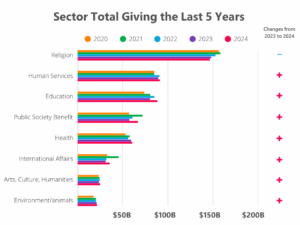A year ago, the words “resilient” and “optimistic” dominated analysis of the Giving USA Foundation’s annual report on philanthropy. Financial and economic security are key determinants of philanthropic giving, and major economic indicators—GDP growth, stock market performance, and increased disposable income—pointed away from the uncertainty that dampened charitable giving in 2023 toward a return to meaningful growth in 2024.
The optimism that economic security would unlock American’s generosity and bring about a resurgence in charitable giving was well placed. Giving to U.S. charities in 2024 reached an estimated $592.5 billion, a growth of 6.3% in current dollars and a new high. For the first time in three years, giving grew in inflation adjusted dollars as well (growing 3.3% in 2024), increasing the ability of nonprofits to deliver more on their missions. This is consistent with the average growth in giving of 5.5%.
Philanthropic giving growth is back on track with the long-term trends of the sector, with 40-year averages of 5.5% growth in current dollars (2.7% adjusted for inflation).
The 2024 giving data confirms what many in the nonprofit sector have long believed: Generosity is not a fleeting response to crisis—it’s a sustained commitment. Donors’ desire to improve the world is deeply rooted. While it may waver amidst economic uncertainty, when paired with a strong economy, generosity becomes a catalyst for growth.
BWF is pleased to share key findings and analysis from Giving USA 2025: The Annual Report on Philanthropy. Presented by the research team at the Indiana University Lilly School of Philanthropy and fundraising professionals at Giving USA Foundation, the Giving USA report is the longest-running, most extensive report on philanthropy in the United States. BWF is proud to be a member of The Giving Institute.
Perspective in a Moment of Uncertainty
Halfway through 2025, the nonprofit sector faced significant disruption and uncertainty. Shifting federal policies in grantmaking, research funding, and diversity, equity, and inclusion have given organizations across all sectors pause, forcing decisions to be made even as policies continue to change. Nonprofits are planning for a future without clarity, knowing only that things will be different and that the old rules may no longer apply.
Understanding the trends and data becomes even more important in a moment like this one. Donors will continue to give to causes and missions they believe in. Knowing where to focus your efforts and how to meet donors at this time will differentiate organizations that persist and those that struggle. Meeting the moment starts with understanding the current state of philanthropy and developing plans to inspire donors to continue to give.
Key Findings from Giving USA 2025
- Total estimated charitable giving reached a new current-dollar high of $592.50 billion in 2024, up from $557.16 billion in 2023—an increase of 6.3% in current dollars and 3.3% when adjusted for inflation.
- All four sources of giving grew in current dollars, but only individuals and corporations saw real (inflation-adjusted) growth. Bequests declined slightly, and foundation giving remained flat when adjusted for inflation.
- Giving by individuals totaled $392.45 billion, growing 8.2% in current dollars and 5.1% when adjusted for inflation. Individuals remain the largest source of giving, accounting for 66% of total contributions.
- Foundation giving reached $109.81 billion, a 2.4% increase in current dollars, but was flat when adjusted for inflation (-0.5%). Foundations now represent 19% of total giving, continuing a long-term upward trend.
- Bequest giving declined to $45.84 billion, a 1.6% decrease in current dollars and a 4.4% decline when adjusted for inflation. Bequests continue to represent 8% of total giving.
- Corporate giving hit a record $44.40 billion, up 9.1% in current dollars and 6.0% when adjusted for inflation, driven by strong GDP growth and corporate pre-tax profits.
- Seven of nine subsectors saw real growth in giving. Four subsectors reached all-time highs even after adjusting for inflation:
- Education: $88.32 billion (+13.2% current, +9.9% real)
- Health: $60.51 billion (+5.0% current, +2.0% real)
- Arts, Culture, and Humanities: $25.13 billion (+9.5% current, +6.4% real)
- Environment/Animals: $21.57 billion (+7.7% current, +4.6% real)
- Giving to religion grew 1.9% in current dollars but declined 1.0% when adjusted for inflation, continuing a decades-long trend of declining as a share of overall giving.
- Public-society benefit organizations saw a 19.5% increase in current dollars and 16.1% when adjusted for inflation, reaching $66.84 billion, driven in part by growth in donor-advised funds (DAFs).
| Inflation adjusted numbers* | 2020 | 2021 | 2022 | 2023 | 2024 | % change from 2023 to 2024 |
| Religion | $156.35B | $158.08B | $152.76B | $148.07B | $146.54B | -1.0% |
| Human Services | $84.88B | $84.88B | $90.81B | $89.38B | $91.15B | +2.0% |
| Education | $73.77B | $80.49B | $85.01B | $80.33B | $88.32B | +9.9% |
| Public Society Benefit | $57.10B | $72.01B | $60.83B | $57.56B | $66.84B | +16.1% |
| Health | $53.14B | $57.70B | $55.96B | $59.34B | $60.51B | +2.0% |
| International Affairs | $32.88B | $45.51B | $31.86B | $31.09B | $35.54B | +14.3% |
| Arts, Culture, Humanities | $23.35B | $24.19B | $24.57B | $23.63B | $25.13B | +6.4% |
| Environment/Animals | $17.74B | $20.36B | $20.40B | $21.20B | $21.57B | +4.6% |
Breaking Down Important Trends from Giving USA 2025
Individual Giving Grew but Slightly Decreased in Share of Total Giving
Individual giving grew in 2024, both in absolute dollars and in inflation-adjusted terms. It remains the single greatest source of philanthropy to nonprofits at an estimated $392.45 billion.
However, individual giving declined as a share of total giving—from 67% in 2023 to 66% in 2024—signaling potential structural shifts in philanthropy. Foundations and corporations are steadily increasing their share of total philanthropy, driven in part by the rise of DAFs and the strength of the economy.
Mega Gifts Remain Flat as Individual Giving Grows
As gifts from ultra-high-net-worth individuals continued to make headlines, mega gifts held steady at about 3% of individual giving, despite the total falling slightly ($11.90 billion in 2023 vs. $11.72 billion in 2024). The consistency in mega gift volume suggests that ultra-high-net-worth donors remain committed to and active in philanthropy.
This trend reinforces the importance of strong major and principal gift strategies, as growth in the total value of individual giving is not being driven by the growth of mega gifts.
Human Services Holds #2 Subsector Spot
For the second consecutive year, Human Services organizations received the second-largest share of American philanthropy, having surpassed Education in 2023 and holding that lead in 2024. Giving to Human Services reached $91.15 billion in 2024, reflecting a 5.0% increase in current dollars and a 2.0% increase when adjusted for inflation.
The fact that Human Services has maintained its lead over Education, even as Education giving also grew significantly, signals a shift in donor priorities, which continue to prioritize basic needs and community supporting causes—especially in the wake of pandemic-era disruptions and ongoing economic uncertainty. This highlights the importance of articulating impact in human-centered terms and aligning messaging with the values driving donor behavior today.
Giving to Religion Dips Below 25% of Philanthropy
Giving to Religion once represented the majority of U.S. philanthropy, accounting for approximately 53% of giving in 1987. In 2024, Religion received $146.54 billion out of $592.50 billion—approximately 24.7% of overall philanthropy. It is one of two subsectors that did not grow in inflation adjusted dollars in 2024.
Declines in Donor Counts Continue
While total charitable giving reached a record high in 2024, the number of donors continues to decline. Donor participation dropped by 4.5% from 2023 to 2024. This decline is not new, but it is accelerating, signaling a continuing shift in which fewer donors are giving more dollars.
While increased giving from existing donors may help organizations offset these losses in the near term, it is only a temporary fix. Donor attrition and low retention rates erode the pipeline for future revenues and prospects.
Corporate and Foundation Giving is Poised for Continued Growth
Growth in GDP and corporate pre-tax profits significantly boosted giving. Corporate giving remained steady at 1.1% of pre-tax profits, reaching a historical high in both current and inflation-adjusted dollars. Foundation giving was flat in real dollars year-over-year but exceeded $100 billion for the third consecutive year.
Foundation and corporate giving both continue to grow as shares of overall sources of philanthropy, buoyed by economic growth, increasing the importance, and the promise of foundation and corporate giving programs.
Bequest Giving Falls, Despite Holding Share of Philanthropy
The 2024 data showed bequest giving declined to $45.84 billion—a 1.6% drop in actual dollars and 4.4% decline when adjusted for inflation. While bequests still represent 8% of total giving, this decline signals a shift in how Americans are approaching estate planning and charitable giving.
One answer to this decline is clear through recent research: Americans are simply not creating wills. In 2025, only 24% of Americans have a will—down from 33% just three years ago. More than half have no estate planning documents at all. This widespread avoidance of basic estate planning directly explains why fewer charitable bequests are materializing, even as the population ages and wealth increases.
At the same time, 2024 saw continued growth in donor advised funds, which maintained $251 billion in assets despite market volatility. Wealthy donors are increasingly using DAFs not just for current giving, but as part of their estate planning strategy. They are naming DAF sponsors as beneficiaries and creating succession plans for their accounts rather than making direct charitable bequests. And when affluent individuals do plan their estates, they’re often skipping traditional wills entirely in favor of trusts and other sophisticated vehicles.
Looking Ahead to 2026
Though uncertainty looms large over the nonprofit sector, the fundamentals of philanthropy and successful fundraising remain the same. Fundraisers and nonprofit leaders who prioritize growing their program through a strategic, disciplined focus on fundamentals and what they can control will position their organizations for long-term growth.
Keep Asking but Plan for Extended Major and Principal Gift Timelines
Market volatility and fluctuations year to date have cast a cloud of uncertainty over the direction of the economy, even as markets have returned to levels comparable to where they started the year. This raises questions in the minds of donors about the timing and structure of their gifts:
- Is now the right time to make a transformational gift?
- Can I commit to a multi-year pledge not knowing what lies ahead?
Plan for these questions to shape your cultivation conversations with donors and to anticipate for gifts to take longer to close. This creates an urgency in planning for solicitations between now and the end of the year. It will also require fundraisers to craft compelling cases for why philanthropy is needed now and to think creatively about structuring gifts to best serve their donors.
Embrace the Everyday Donor by Enhancing the Focus on Base and Mid-Level Donors
The continued decline of donor counts represents an existential threat to organizations that do not reverse that trend—it is not inevitable. Fundraisers and nonprofit leaders need to focus on strengthening their donor engagement and retention strategies in ways that prioritize personalization, transparency, and impact. Expanding your donor base is an investment, focusing on the right metrics will be critical. Digital-first stewardship, values-based messaging, and frictionless giving experiences are no longer optional—they are essential. Organizations that build loyalty through thoughtful donor journeys and consistent communication will be best positioned to stabilize and grow their donor base in the years ahead.
Adopt Specific Strategies to Navigate Generational Shifts and the Great Wealth Transfer
One of the most transformative forces on the horizon for philanthropy is the Great Wealth Transfer, with an estimated $84 trillion expected to pass from baby boomers to Gen X, millennials, and Gen Z over the next two decades. To thrive in this evolving environment, organizations must balance the continued cultivation and stewardship of baby boomer donors with intentional cultivation of younger generations.
Baby boomers remain the most generous generation in total giving and hold a majority of the wealth. Robust planned giving strategies that secure some of the $84 trillion expected to transfer to younger generations are an opportunity for nonprofits, as funding from bequests are likely to rise. These donors are increasingly using DAFs and qualified charitable distributions (QCDs) from retirement accounts to give tax-efficiently. Fundraisers need to be prepared to discuss and educate donors about more complex giving vehicles.
Younger donors—particularly millennials and Gen Z—are emerging as influential philanthropic actors. Millennials increased their average household giving by 40% between 2016 and 2022, surpassing Gen X in average annual contributions. These donors are not only generous but also deeply values-driven, prioritizing transparency, social justice, and measurable impact. They also expect to be engaged as partners, not just funders, seeking hands-on involvement and opportunities to advocate for change.
Adapt Planned Giving Strategies to Changing Trends in Estate Planning
Fewer Americans with wills and the rise of DAFs in estate planning mean that planned giving programs need to adapt. Nonprofits must continue cultivating traditional bequest prospects, especially since adults over 60 represent nearly a quarter of the population and have seen 30% wealth growth since 2019. Future conversations must explore how prospective major donors will use DAFs in their philanthropic planning.
Traditional bequest programs remain important, but organizations that add DAF estate planning and non-cash asset strategies will be better positioned to capture the evolving preferences of today’s donors.
Tap the Growing Potential of DAFs and Foundations
DAFs continue to grow in popularity and in size. Meanwhile, foundations are growing in value boosted by recent economic gains. Donors have already allocated the dollars in these entities to be given to nonprofits and realized the tax benefits of giving, which means nonprofits can think differently about soliciting gifts from donors who give through DAFs or foundations.
Cultivation conversations should also emphasize non-cash major gifts. Last year, 63% of DAF contributions came from stocks, real estate, and other appreciated assets rather than cash, offering donors significant tax advantages that cash gifts can’t match.
This type of giving creates opportunities for nonprofits to engage these savvy donors in meaningful conversations with less concern that uncertainty will be raised as an objection. Candid conversations about your organization’s need in this moment and how donors can support you are an opportunity.
Integrate AI into Fundraising and Operating Strategies
When OpenAI launched ChatGPT in November 2022, nonprofits began assessing whether they needed an AI strategy. With nonprofits now launching AI gift officers, the conversation is no longer whether your organization needs a strategy but rather how it will integrate AI tools across the organization’s operations.
Nonprofits that successfully embrace this next wave in the IT revolution will be those who thoughtfully review their fundraising programs and operations, asking how AI technologies fit into their workflows to free staff to focus on the most important aspects of their work:
- How can we use our AI-tools to increase donor retention through scaled engagement?
- What insights can AI help us glean to identify our best next major gift prospects?
- Do we have a roadmap and training plan in place to upskill our team to make the most of what AI makes possible?
Giving USA 2025 Conclusion: Through Uncertainty and Hardship, Donors Give
It is easy to question the value of historical trends in moments of unprecedented uncertainty. The nonprofit sector is not alone in navigating the impact of the new administration’s policies, but nonprofits are uniquely exposed to the changes proposed and enacted in the last six months.
Yet the data and trends are clear.
- Philanthropy is resilient. Through recessions and uncertainty, it holds.
- Giving continues to grow. The growth and impact may be tempered by the economy, but giving is growing.
- Donors prioritize supporting nonprofits that can affect the change they seek in the world.
Generosity is persistent. No matter the hardship, donors looking to change the world and improve their communities find ways to give. Embracing the opportunity to help donors change lives through generosity will help nonprofits navigate this moment and continue to deliver on their missions.







